#105 U.K. JET Fusion Reactor Produces More Five-Second Reactions After 25 Years
Return to ITER Power Facts Main Page
By Steven B. Krivit
Feb. 9, 2022
After 25 years, the Joint European Torus (JET) fusion reactor, a collaborative project of the European Union and the United Kingdom, has again produced five-second fusion reactions.
Ian Chapman, the chief executive officer of the United Kingdom Atomic Energy Authority (UKAEA), said in a press conference today that it was a historic result.
“These are genuinely landmark results on the quest for delivering fusion power,” Chapman said.
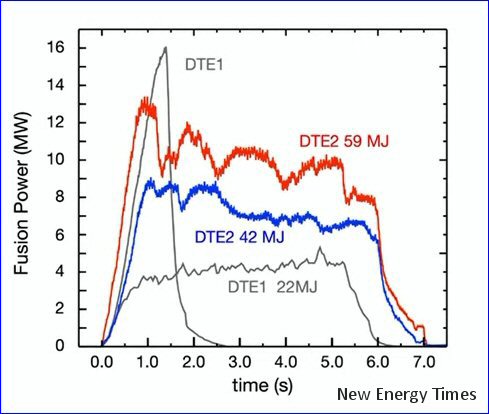
JET record fusion pulses announced Feb. 9, 2022. DTE1 are 1997 results. DTE2 are 2021 results.
Same Duration
Chapman and other scientists at the press conference claimed today that they accomplished their objective for this round of experiments: sustained five-second fusion pulses. However, as the graph they displayed shows, they achieved a five-second pulse 25 years ago but at a lower average power level.
The best new result (shown in the red curve above) averaged 11 megawatts versus the 1997 result averaging 4 megawatts (shown in the grey curve above). Because of the higher power level, one of the new five-second pulses produced more than twice the thermal energy of the 1997 five-second pulse: 59 megajoules instead of 22 megajoules. These energy values do not account for reactor input energy.
In the new experiment, the reactor lost only 98.3 percent of the energy it consumed, which is an improvement over the 1997 result, in which the reactor lost 99.4 percent of the energy it consumed.
Lower Power
In another, shorter experiment in 1997, JET scientists achieved momentary gross thermal power output of 16 megawatts for one-tenth of a second. But the current objective was not intended to break the record for peak output, Tony Donné, the head of EUROfusion, told New Energy Times.
“We didn’t focus on trying to reach a high fusion power in a short pulse, as that is scientifically not interesting; we learn much more from the longer pulses,” Donné wrote.
New Materials
For the new JET experiments, the reactor was retrofitted with new materials — tungsten (W) in the divertor and beryllium (Be) for the plasma-facing wall. The new materials have the advantage of improving fuel performance by reducing the retention of tritium in the walls.
The scientists claimed that the JET tests with the new materials were performed to support the ITER reactor, which will use the same materials. However, testing these materials seems irrelevant because the components for ITER have already been manufactured and are soon to be assembled. Today’s reported tests in JET will not change the design, construction, or materials used in ITER.
Publicity Stunt?
These facts raise questions about the actual purpose of the new round of JET experiments. Donné says that higher fusion power was not a goal for JET. A five-second pulse was achieved 25 years ago. The materials for ITER have already been determined. So why bother running an expensive set of new experiments with radioactive fuel in an old and outdated reactor?
Was this all just a publicity stunt to help sell Chapman’s new proposed U.K. fusion reactor?

Cross-section of JET and ITER fusion vacuum chamber
Still Waiting for Breakeven
Despite a higher power level, the JET reactor still consumed 98 percent of the power it used, just as it did 25 years ago.
The reactor, according to Nick Holloway, a former UKAEA spokesman, consumes electrical power at a rate of 700 megawatts. A 1982 EURATOM document located at the University of Pittsburgh Archive of European Integration supports this value.
That didn’t stop the UKAEA from making bold claims. “The record results announced today are the clearest demonstration worldwide of the potential for fusion energy to deliver safe and sustainable low-carbon energy,” a press release from the UKAEA said today.
For 70 years, fusion scientists have promised that someday a fusion reactor will produce more energy or power than it consumes. We are still waiting.
Even the first required milestone has not been achieved in tokamak reactors. This is called “scientific breakeven,” and it occurs when fusion reactions produce more thermal power than the heating power injected into the fuel.
The next required milestone will be “engineering breakeven,” when a fusion reactor (not just the fusion reaction) produces power at a greater rate than it consumes power.
Ecstatic Experts
On behalf of the UKAEA, a public relations agency, Science Media Centre, today provided a document to journalists with quotes from its panel of experts.
Robin Grimes, Steele Professor of Energy Material at Imperial College London, said:
This is further confirmation that the practical physics of fusion can deliver the energy levels we need to decarbonize our energy needs, not only for electricity but also heat. While there are many engineering challenges to overcome, this provides decision makers with the evidence and thus the confidence needed to keep up the momentum. I hope the UK funding agencies act to ensure that the UK stays at the forefront of this technology as it develops. Of course, the other thing this project has shown is that effective international partnerships are key to success.
Ian Fells, Emeritus Professor of Energy Conversion at the University of Newcastle, said:
The production of 59 Megajoules of heat energy from fusion over a period of 5 seconds is a landmark in fusion research. Now it is up to the engineers to translate this into carbon-free electricity and mitigate the problem of climate change. Fusion was initiated with the explosion of the hydrogen bomb in 1952; its potential was realized, but it has taken until now to achieve 5 seconds of fusion, a formidable success. 10-20 years could see commercialization.
Mark Wenman, Reader in Nuclear Materials at Imperial College London, said:
These exciting new results from JET clearly show that it can be achieved in a tokamak similar to the new, larger, more powerful ITER device. For me, this means we can expect big things from ITER and that fusion energy really is no longer just a dream of the far future – the engineering to make it a useful, clean power source is achievable and happening now.
Even though the new results again showed that a fusion reactor is far from producing practical levels of energy, the UKAEA press said that “record results announced today are the clearest demonstration worldwide of the potential for fusion energy to deliver safe and sustainable low-carbon energy.”
The release quoted Bernard Bigot, the director-general of JET’s successor, the International Thermonuclear Experimental Reactor, ITER:
A sustained pulse of deuterium-tritium fusion at this power level – nearly industrial scale – delivers a resounding confirmation to all of those involved in the global fusion quest. For the ITER Project, the JET results are a strong confidence builder that we are on the right track as we move forward toward demonstrating full fusion power.”
But “nearly industrial scale” exaggerates JET’s gross output of 59 megajoules of energy. An ordinary 60 amp-hour 12-Volt car battery has a 2.6 megajoule capacity. So the JET result was equivalent to about 23 car batteries — as long as you don’t count the energy consumed by the reactor.
With an input power of 700 megawatts and a duration of 5 seconds, JET consumed 3,500 megajoules compared with the produced 59 megajoules.
ITER Power Misrepresentations
Today’s press conference included misleading and exaggerated power claims about ITER from Chapman. It’s neither the first nor the second time Chapman has done so, as my film “ITER, The Grand Illusion: A Forensic Investigation of Power Claims” shows.
For three decades, fusion scientists, through the use of misleading language and the failure to disclose input power requirements, have implied that the ITER reactor is designed to produce 10 times the power it is designed to consume. At times, fusion scientists have stated these false claims directly. But most of them stopped the deceptive practice after I reported the power facts on Oct. 6, 2017.
But not Chapman — not even after I worked with Holloway in 2018 and 2020 to correct the false ITER power statements on the UKAEA Web site.
Chapman spoke today about fusion research as a noble quest:
If we are to deliver fusion as part of the wider effort to address climate change, we must do that by working together. We are hugely proud of the collaboration in our community. Fusion has been described already, even today, as a quest. I think that’s a very apposite word. A quest is noble, it’s something that matters. It really matters to our planet, to our people.
ITER is the largest scientific collaboration ever undertaken by human kind. In my view, perhaps the most important. And it will aim to prove that fusion is possible on a commercial scale.
Actually, if ITER works as designed, with a net loss of power, it will prove that fusion is not possible on a commercial scale.
While he was speaking, Chapman displayed this slide, indicating that ITER was designed for a tenfold power gain:
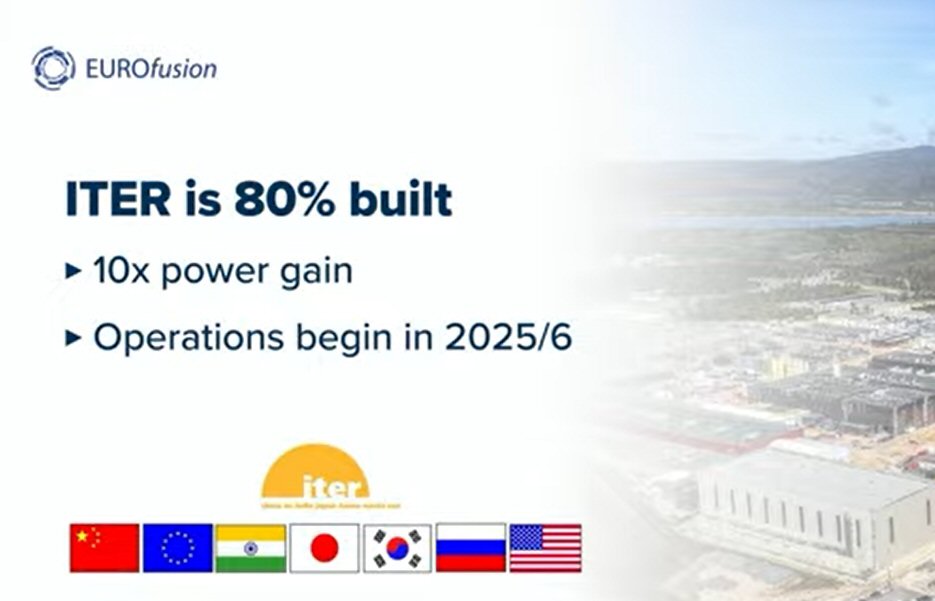
A moment later, Chapman, using virtually imperceptible print, revealed the details more precisely.
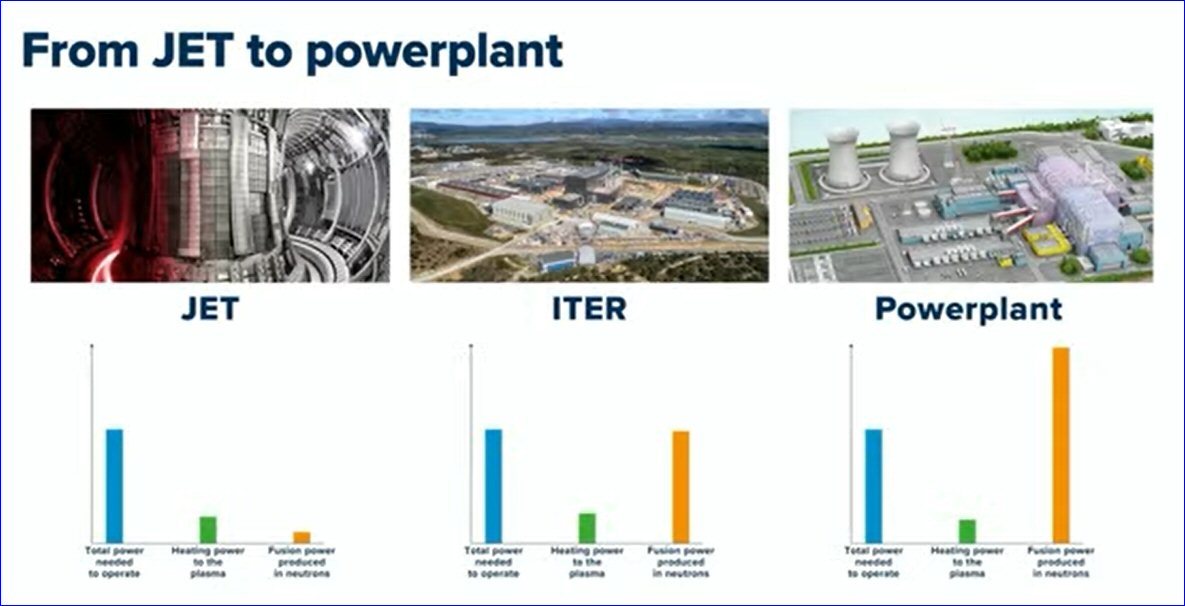
Here’s a closer look:
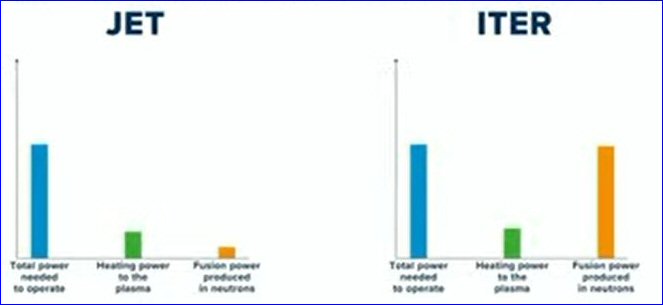
In case they are still hard to read, here are the labels for each of the three columns above, for both reactors:
- Total power needed to operate
- Heating power to the plasma
- Fusion power produced in neutrons
Chapman’s histogram chart for ITER above is generally correct, and it shows that the reactor is not designed to produce net power. Therefore, it won’t produce net energy, either.
Below, I show a more precise comparison of the total power needed to operate ITER and the projected power output. If ITER works as designed, the reactor will demonstrate a net loss of power. Full details and sources are here.

Later in the press conference, when asked by a journalist about fusion progress, Chapman made the false ITER power claim again. Chapman did so without adding the qualifier that he was referring to only the planned plasma power gain, or informing journalists of the full power required to operate ITER.
Chapman said, “We have a high confidence that ITER will reach its goal, as Tim [Luce, the chief scientist of the ITER organization], said. ITER’s goal is to produce a ten-times power gain. You put 50 megawatts in, and you produce 500 megawatts.”
[Ed: Luce did not say that. Chapman falsely attributed his false statement to Luce. Luce very precisely and accurately described the goal of ITER. Read here.]
Unlimited Fuel?
In the press release, the UKAEA told journalists that the fuel for fusion is virtually unlimited and available everywhere:
Fusion, the process that powers stars like our sun, promises a near-limitless green electricity source for the long term, using small amounts of fuel that can be sourced worldwide from inexpensive materials. The fusion process brings together atoms of light elements like hydrogen at high temperatures to form helium and release tremendous energy as heat. Fusion is inherently safe in that it cannot start a run-away process.
Also, in the materials provided along with the press release, the UKAEA told journalists that each future fusion power station “will need 400 kilograms per year of deuterium and tritium fuel.”
Fusion Fuel Propaganda
In fact, the required fuel sources for commercial nuclear fusion reactors do not exist.
The total, global inventory of tritium is now at its peak — right around 60 kilograms. That’s not enough tritium for one fusion power station for a year. After 2060, tritium is not expected to be produced, except for use in nuclear weapons by the military.
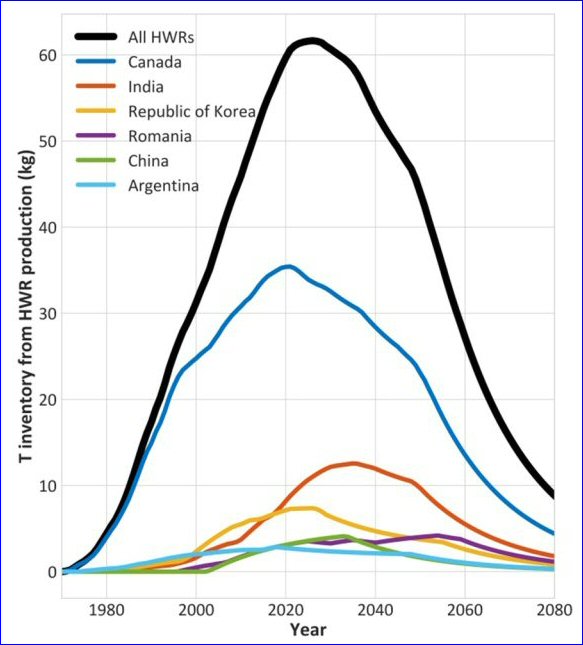
Source: Kovari et al., “Tritium Resources Available for Fusion Reactors,” (Dec. 21, 2017) Nuclear Fusion, 58 (2)
No Tritium?
But all hope is not lost. Fusion scientists know that, in the laboratory, lithium can be bombarded with neutrons to breed tritium.
Donné explained this to New Energy Times:
There is a vast amount of lithium in the world. Much of that is used in batteries (and can be reused afterwards). About 92.5% is Li-7, the rest Li-6. For a fusion reactor of 2 GWe, we would need about 250 kg lithium per year. This is a minute amount, and even for hundreds of reactors, we are not talking about giant amounts.
Tritium is indeed a scarce resource – also a reason that we don’t conduct DT experiments every day – and the world commercial supply (coming as a byproduct from the CANDU type of fission reactors) is on the order of 20-25 kg. This is why, in future fusion devices, we do need to breed our own tritium.
In other words, the reactors need to be tritium self-sufficient. This is why, in the EU DEMO, we are aiming at the tritium breeding ratio of about 1.1. So I am personally convinced we have the fusion fuel for thousands of years.
The Enriched-Lithium Fairy
But natural lithium, which is primarily composed of lithium-7, will not work well enough. Fusion reactors will need lithium enriched in the lithium-6 isotope. For small, scientific experiments, enriched lithium is not a problem to acquire; it’s available in chemical supply houses. The problem is that fusion reactors will need tons of enriched lithium.
Alexander M. Bradshaw, a physical chemist at the Max Planck Institute for Plasma Physics, in Germany, wrote that a 2 GW thermal output reactor, which is equivalent to a 0.8 GW electric reactor, will require 292 kilograms of enriched lithium per year. Bradshaw also explained that the initial loading of enriched lithium into reactors will require 22,000 kilograms of 90% enriched lithium-6 or 9,000 kilograms of 36% enriched lithium-6 depending on the neutron multiplier used.
According to a peer-reviewed research paper by scientists at the Karlsruhe Institute of Technology, in Germany, no facility in the world can produce the required quantities of lithium-6:
The need for enriched lithium-6 in large quantities asks for an isotope separation process that allows a minimum output of several tons of fusion-grade lithium (that is, lithium with an isotopic composition that can directly be used in the blankets) per full power year. As far as we know, no facility is available world-wide that could satisfy this demand, and it is also not straightforward to build such a plant. Hence, a suitable process has to be developed, which poses a special challenge for process engineers: Isotope separation is usually very energy-demanding and complex, leading directly to large investments.
Moreover, according to a 2013 GAO report, enriched lithium is produced only by China and Russia. They produce lithium-6 in limited quantities for their nuclear weapons programs using a mercury-based process that was outlawed in the U.S. decades ago.
I asked Donné about his planned source for thousands of kilograms of enriched lithium.
“We have enough time until the fusion reactors are rolled out to develop the technology and set up plants to enrich the lithium,” Donné wrote.
The Tritium Breeding Ratio Deal-Breaker
The question of whether fusion reactors could breed tritium fast enough to compensate for consumption and losses has been answered in a peer-reviewed paper published in the preeminent journal Nuclear Fusion in 2020:
We focus in particular on components, issues and research and development necessary to satisfy three “principal requirements”: (1) achieving tritium self-sufficiency within the fusion system, (2) providing a tritium inventory for the initial start-up of a fusion facility, and (3) managing the safety and biological hazards of tritium. A primary conclusion is that the physics and technology state-of-the-art will not enable [the European] DEMO [reactor] and future power plants to satisfy these principal requirements.
The authors represent renowned fusion research laboratories:
Mohamed Abdou, University of California, Los Angeles
Marco Riva, University of California, Los Angeles
Alice Ying, University of California, Los Angeles
Christian Day, Karlsruhe Institute of Technology, Germany
Alberto Loarte, ITER Organization
Baylor, Oak Ridge National Laboratory, U.S. Department of Energy
Paul Humrickhouse, Idaho National Laboratory, U.S. Department of Energy
Thomas F. Fuerst, Idaho National Laboratory, U.S. Department of Energy
Seungyon Cho, National Fusion Research Institute, Republic of Korea
Why?
A brochure provided to journalists by the UKAEA asks the question: “Why Is the World Investing in Fusion Energy?”
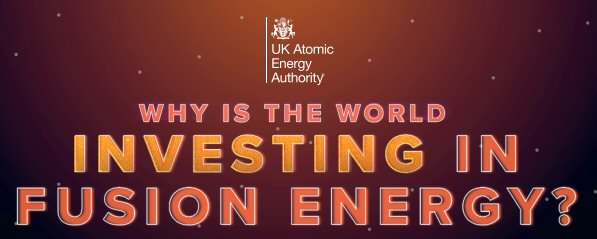
The answer, provided by the UKAEA, is that fusion energy is low-carbon, abundant, safe, efficient, and innovative.
Despite never having produced even one net Watt of thermal power from fusion, compared to reactor input power, let alone one usable Watt of electricity, the UKAEA would like journalists to tell the public that “fusion can provide reliable, continuous electricity with no greenhouse gas emissions.”
Despite no known source for industrial quantities of tritium or enriched lithium, the UKAEA would like journalists to tell the public that “fusion fuel reserves will last for many tens of thousands of years, and that tritium will be produced inside fusion machines from lithium.”
Further Reading:
The Fuel for Nuclear Fusion Doesn’t Exist
The Tritium Fusion Fuel Discrepancy: The Scientific Facts
Lithium, Lithium, Everywhere, and None to Use for Fusion Reactors

